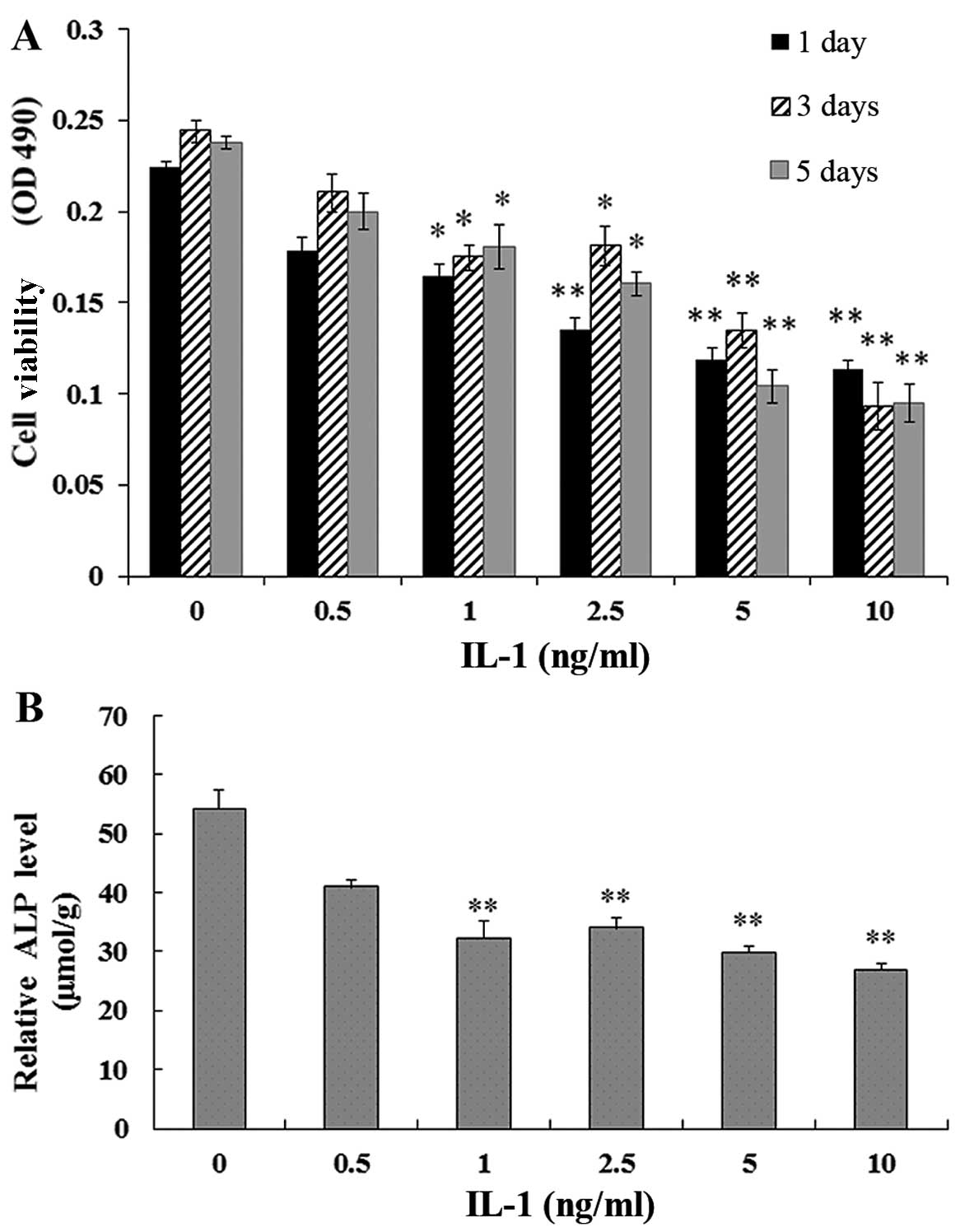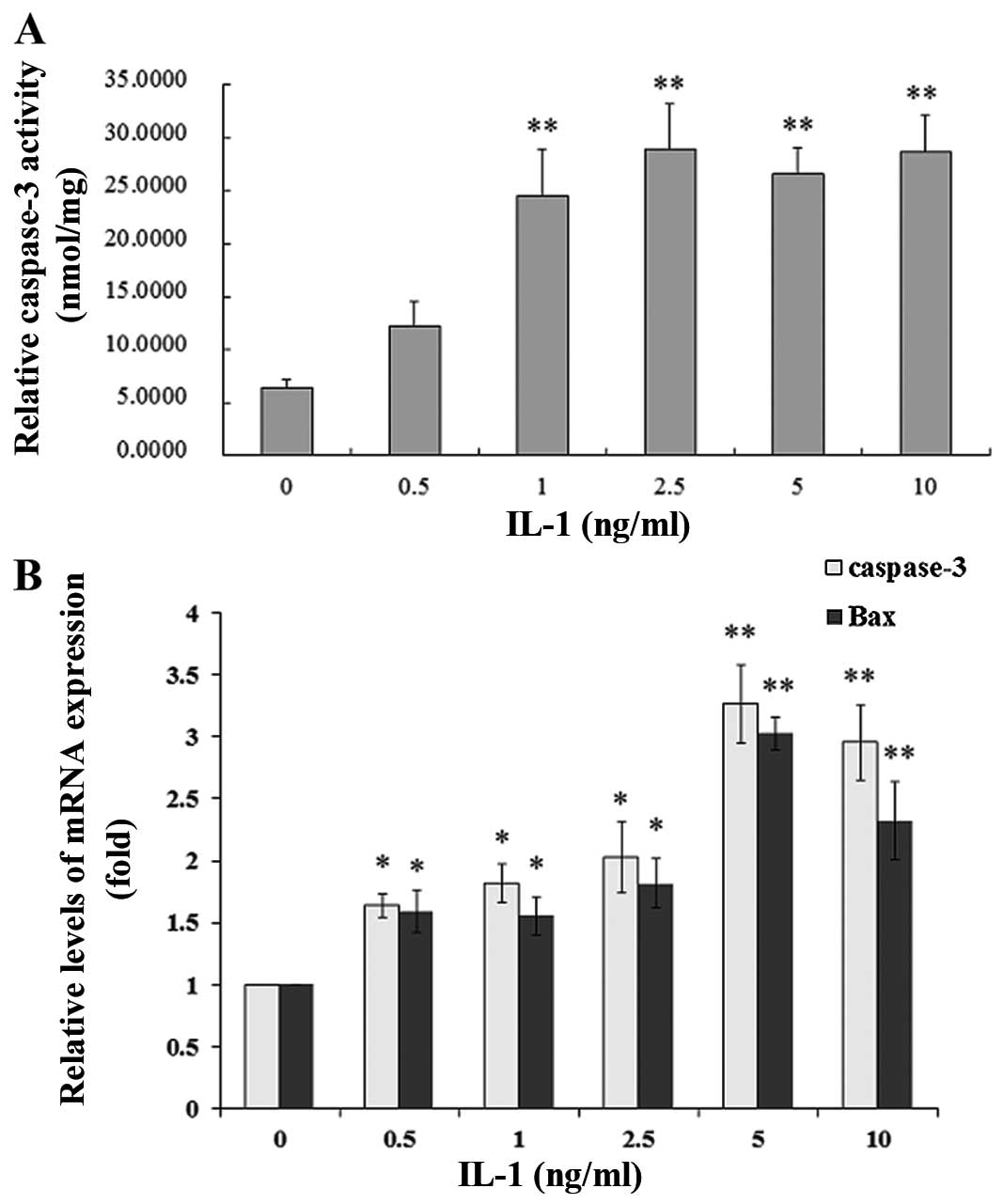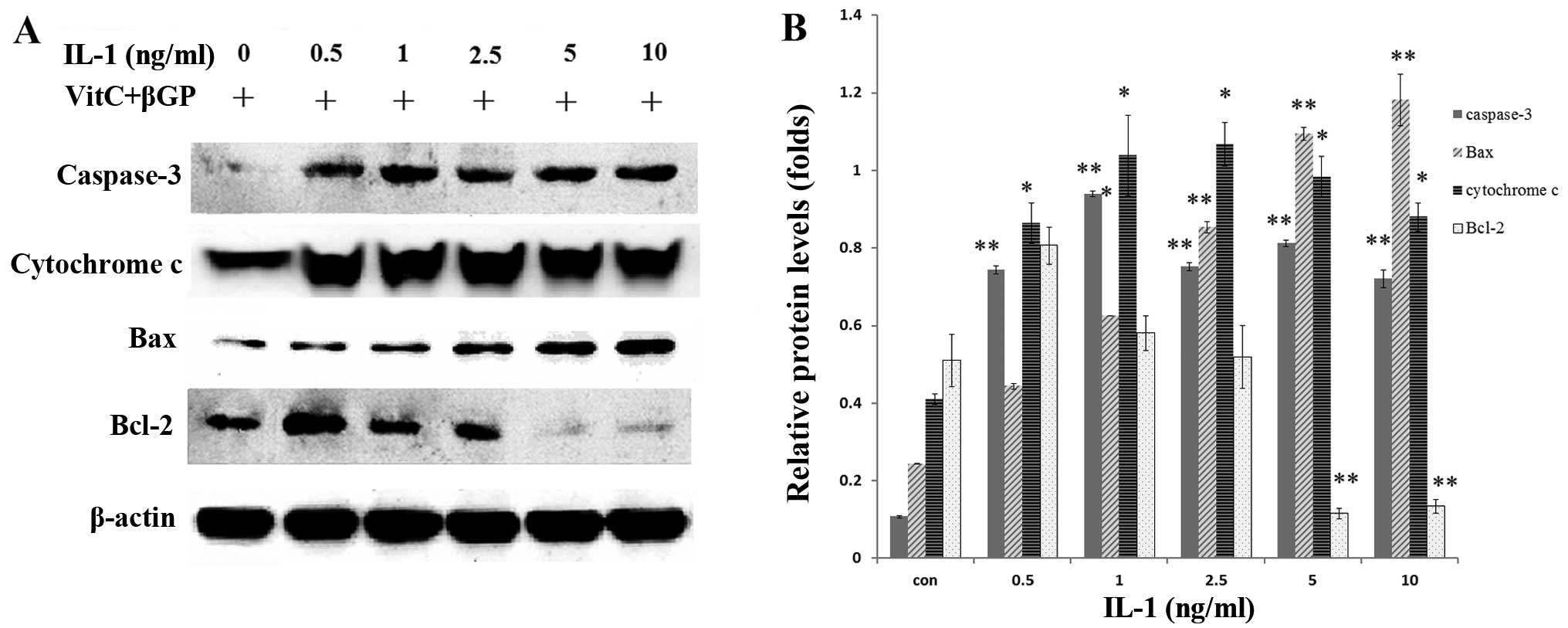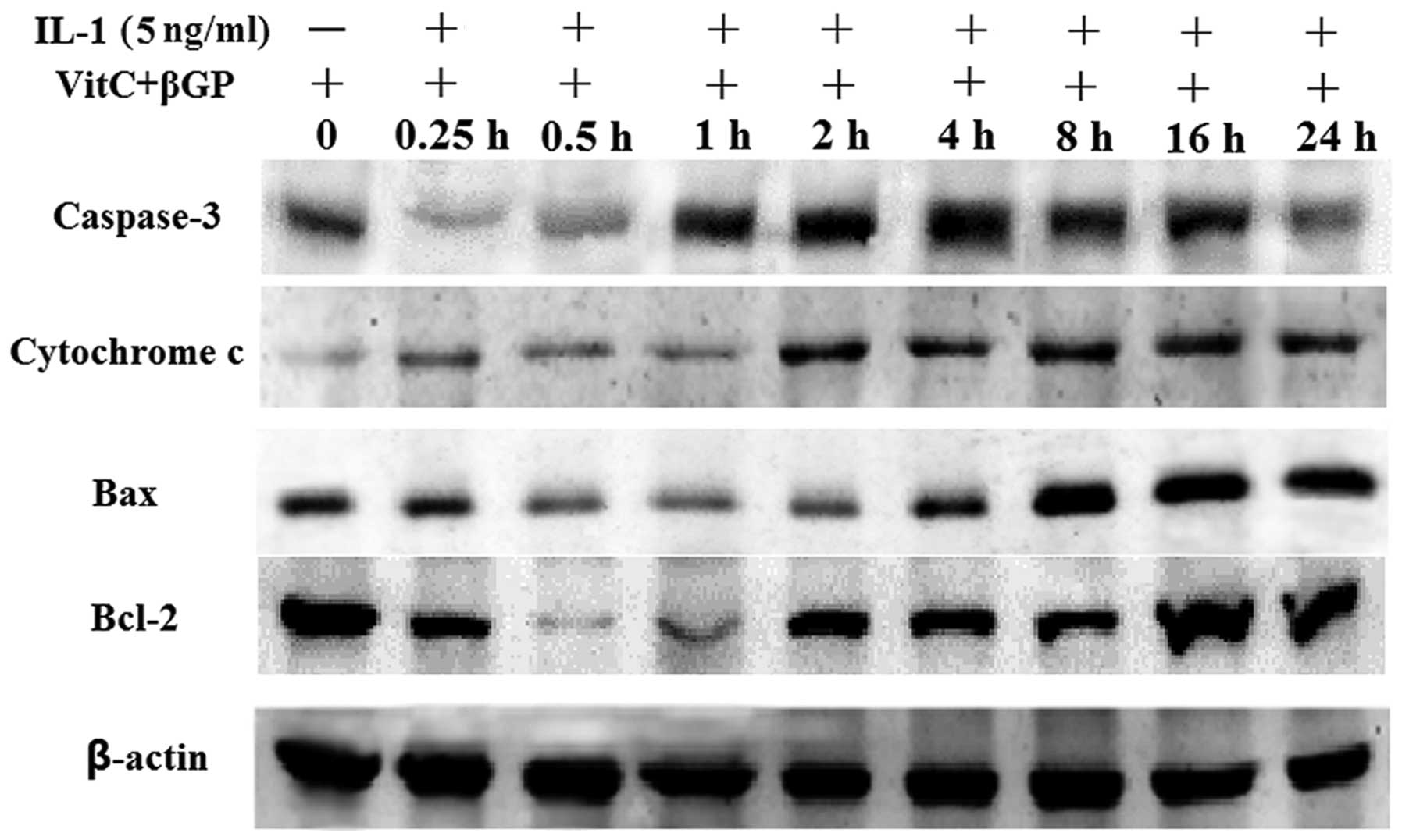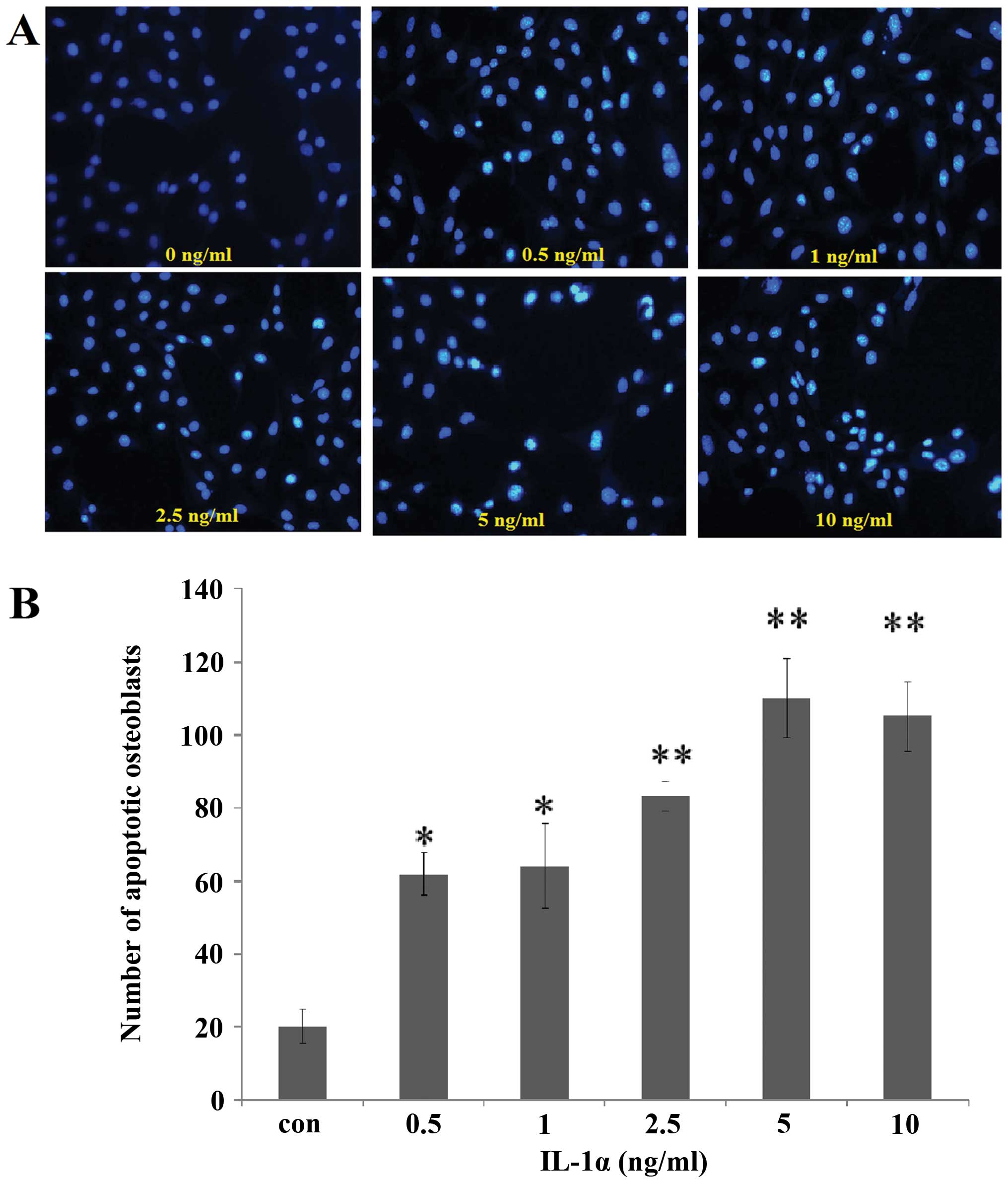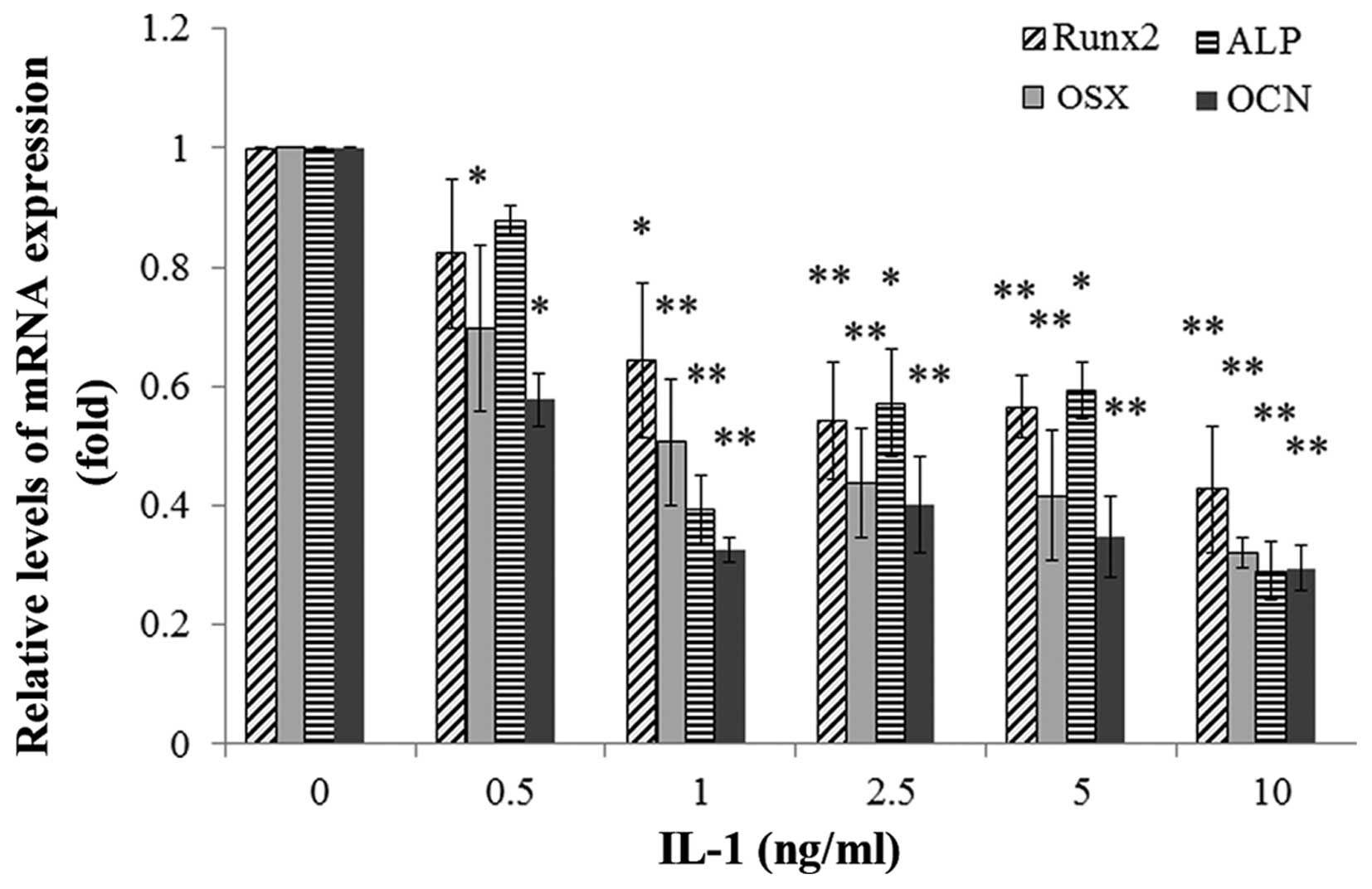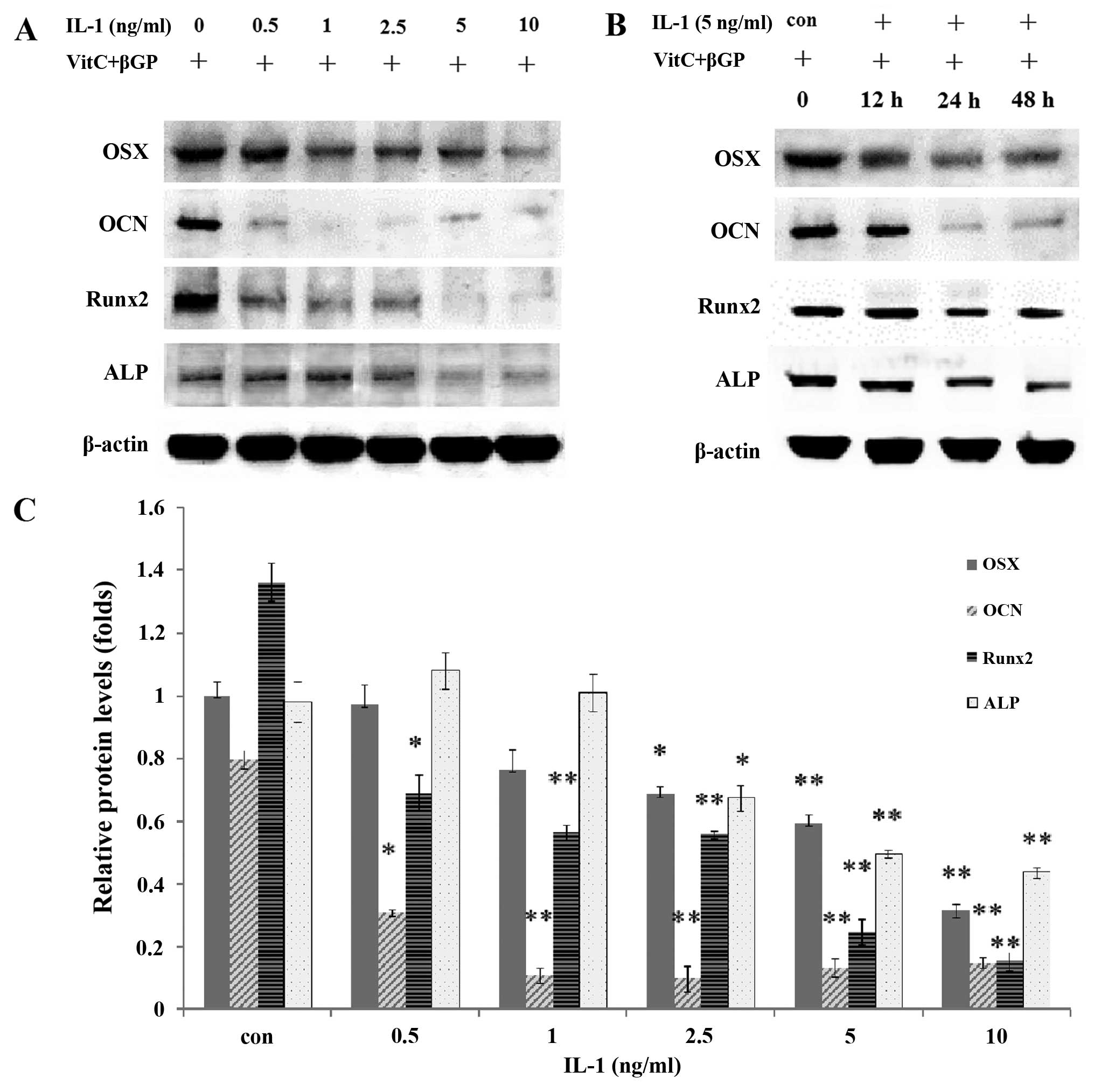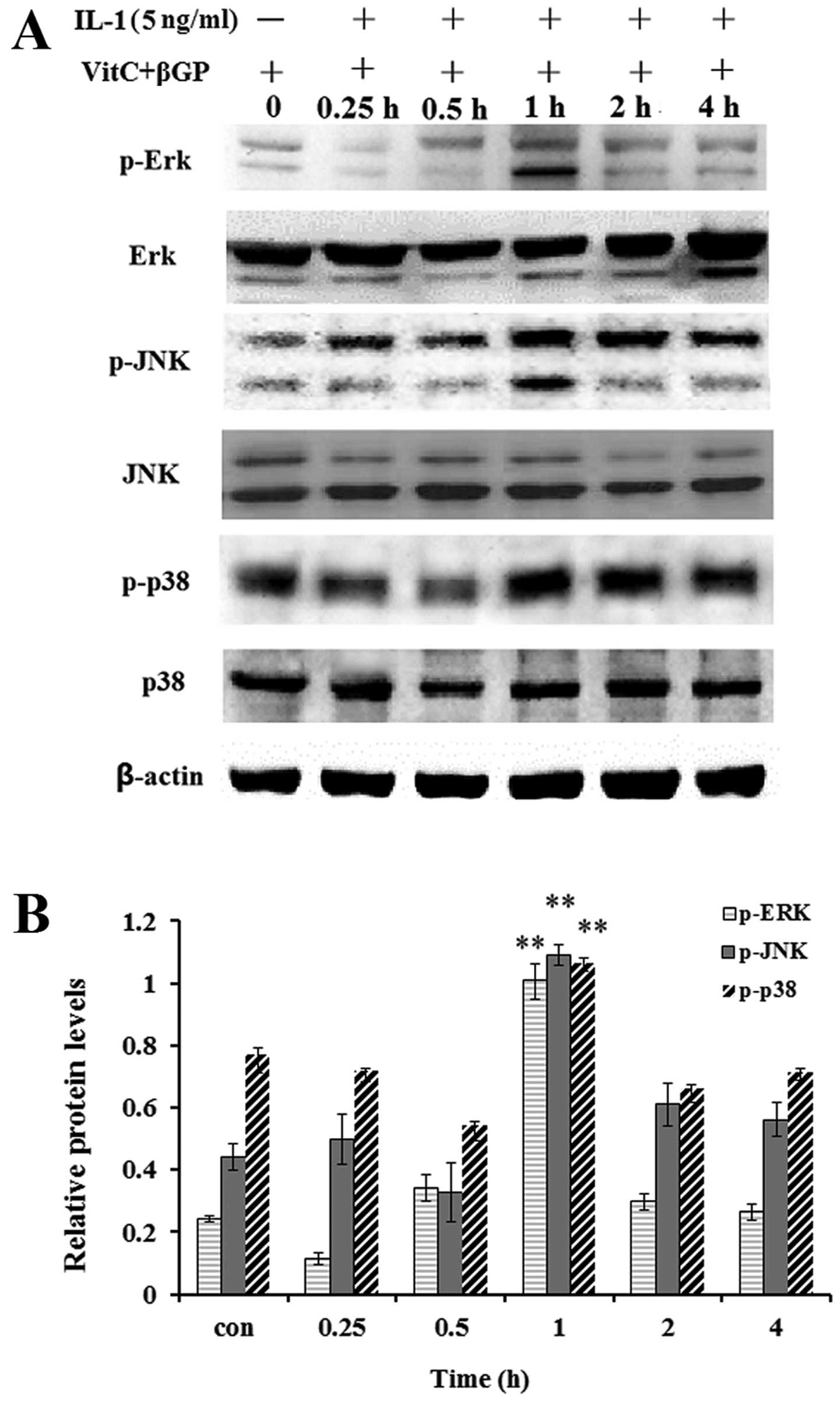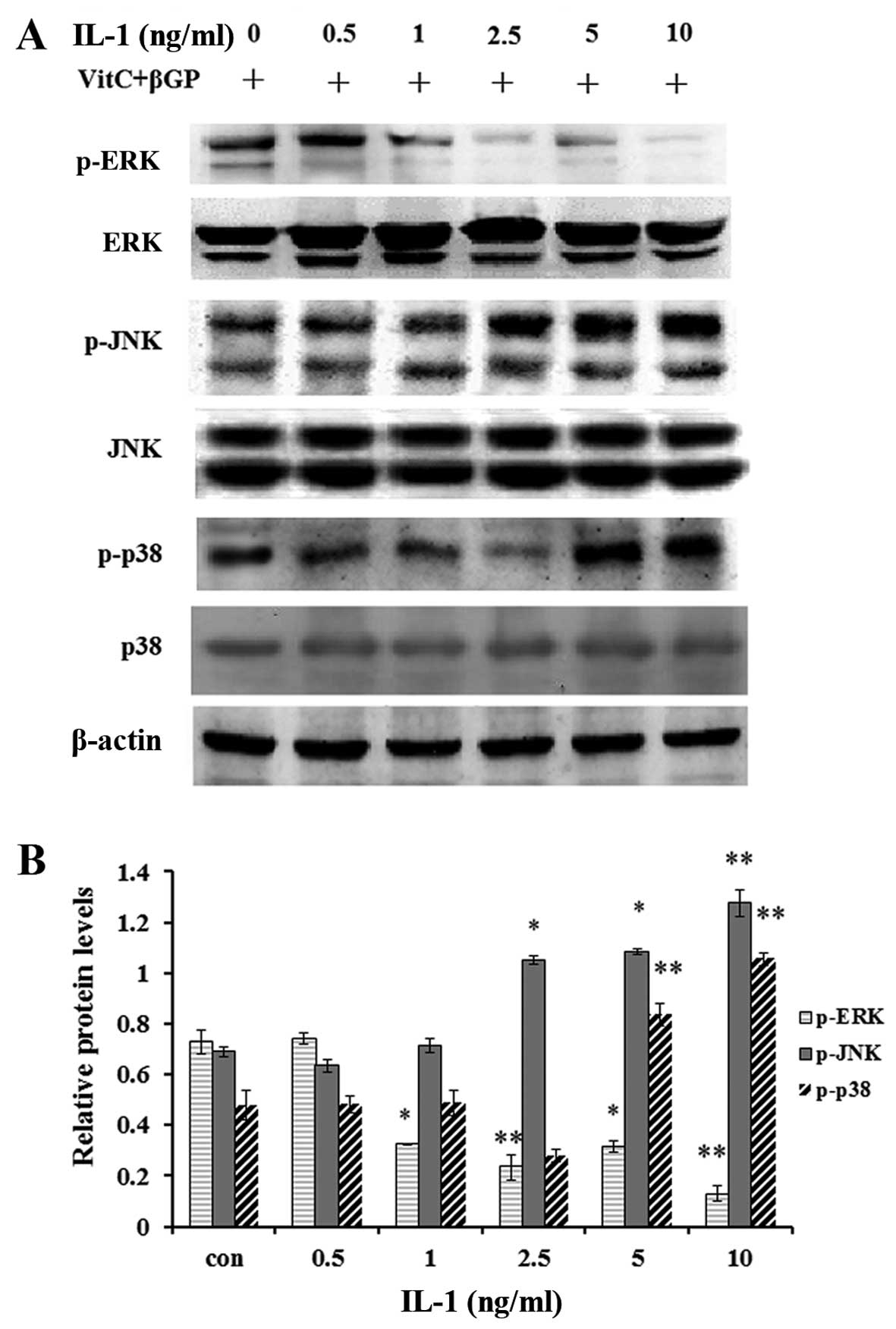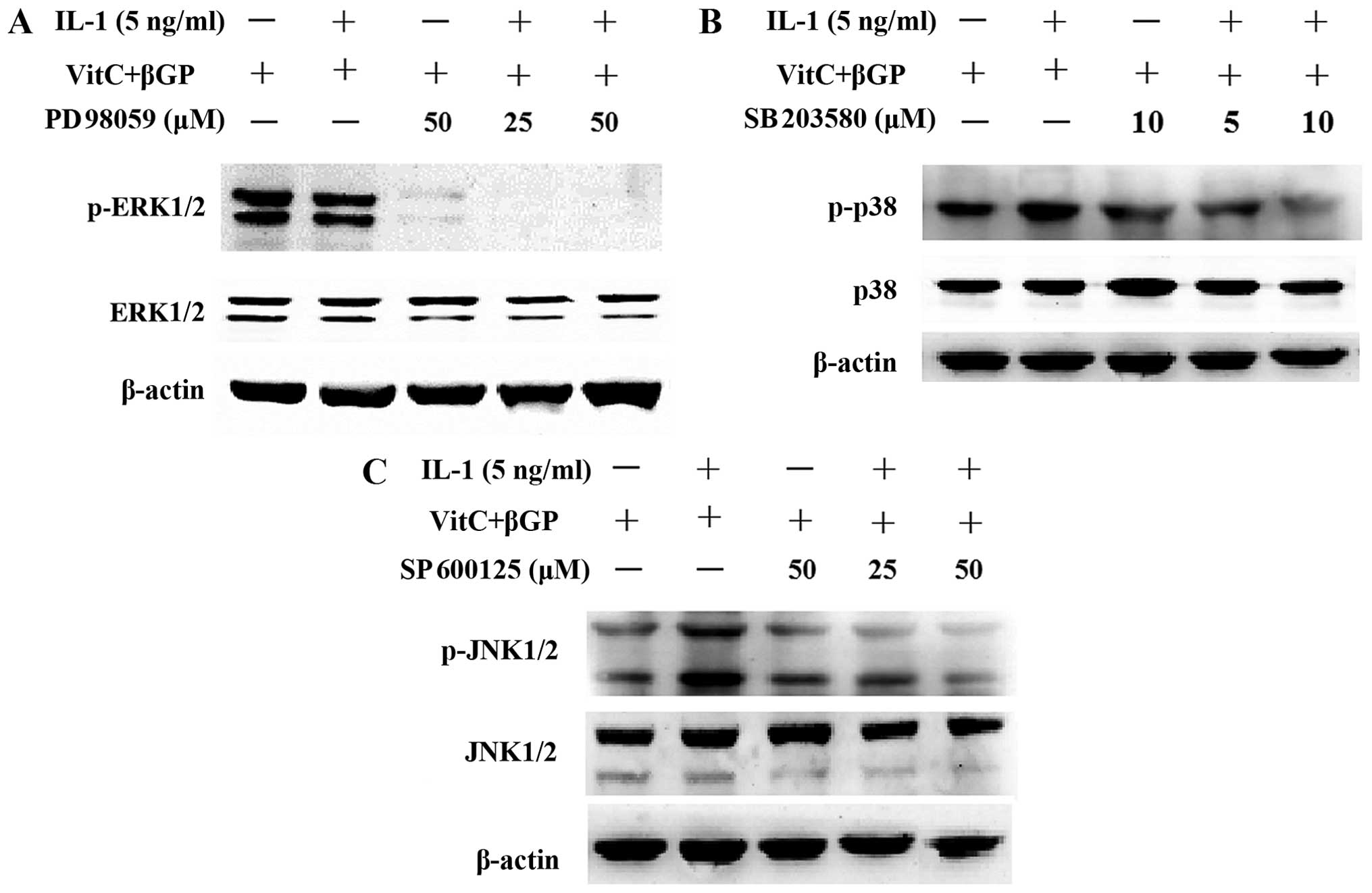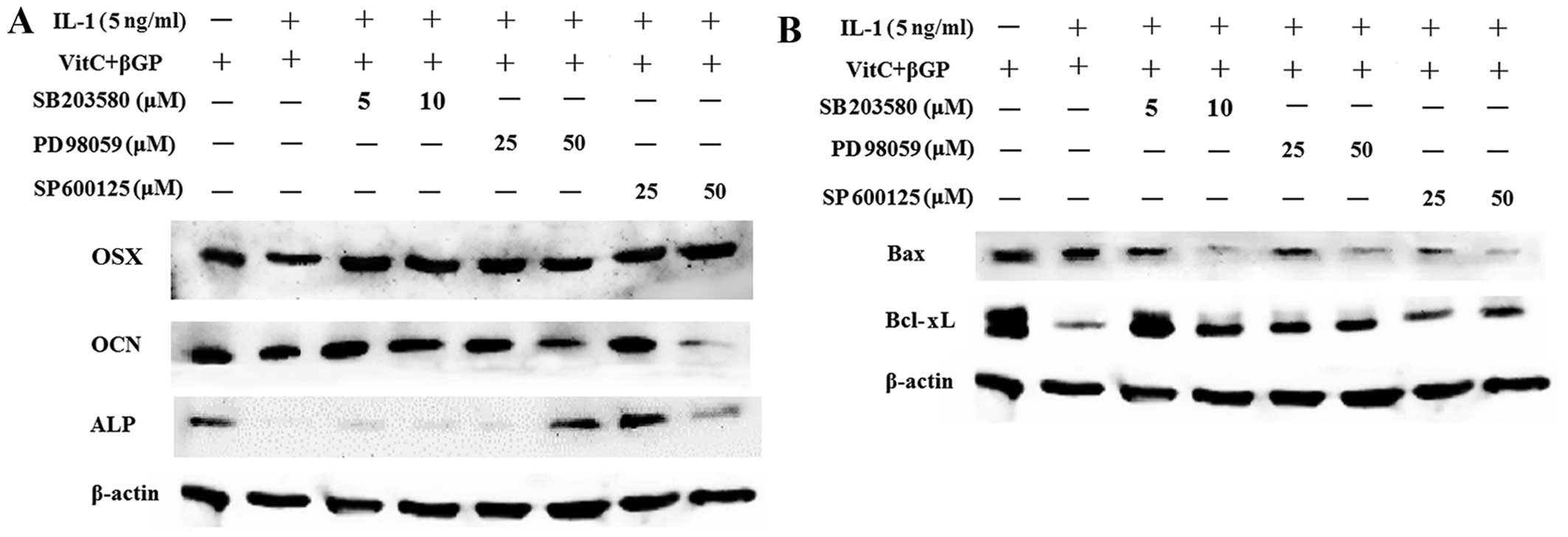IL-1α induces apoptosis and inhibits the osteoblast differentiation of MC3T3-E1 cells through the JNK and p38 MAPK pathways
- Authors:
- Published online on: May 25, 2016 https://doi.org/10.3892/ijmm.2016.2606
- Pages: 319-327
Abstract
Introduction
Bone is a dynamic tissue that constantly undergoes remodeling through a coupled process of bone formation by osteoblasts and resorption by osteoclasts throughout life (1). Chronic osteomy-elitis, a persistent infection of the bone, involves dysregulation of this process which results in excessive bone resorption (2).
Interleukin (IL)-1 is a proinflammatory cytokine that plays important roles in inflammation and host responses to infection (3,4). Once released, IL-1 elicits a multitude of effects on target cells that lead to and modulate the inflammatory response as well as tissue damage (3). The two forms of IL-1, IL-1α and IL-1β, have similar biological activities but different functional roles in the body (3,5). Bone is highly sensitive to IL-1, which is involved in the regulation of bone formation (6–8) and bone resorption (9–12).
Mitogen-activated protein kinases (MAPKs, also known as MAP kinases), including c-Jun N-terminal kinase (JNK) and p38, are involved in the progression of inflammatory responses and in the apoptosis of osteoblasts (13–15). Moreover, the mechanism responsible for the effects of IL-1 on the differentiation and apoptosis of osteoblasts, which may occur through the MAPK signaling pathways, remains unclear. Thus, research into the effects of IL-1 on osteoblast differentiation and function as well as the subsequent development and evaluation of potential drugs suitable for preventing bone destruction in infective bone diseases remains an area of great interest.
The aim of the present study was to evaluate the mechanism responsible for the effects of IL-1α on the differentiation and apoptosis of osteoblasts. We also aimed to elucidate the mechanism through which IL-1α induces MAPK phosphorylation.
Materials and methods
Reagents
IL-1α was purchased from PeproTec (Rocky Hill, NJ, USA). 3-(4,5-Dimethylthiazol-2-yl)-2,5-diphenyltetrazolium bromide (MTT), 4-(2-hydroxyethyl)-1-piperazineethane-sulfonic acid (HEPES), protease inhibitor cocktail, and the selective MAPK inhibitors SB203580, PD98059 and SP600125 were all purchased from Calbiochem (San Diego, CA, USA). An alkaline phosphatase (ALP) colorimetric assay kit and a caspase-3 activity kit were purchased from Beyotime Institute of Biotechnology (Shanghai, China). Dulbecco's modified Eagle's medium (DMEM), fetal bovine serum (FBS) and penicillin/streptomycin were purchased from Gibco (Rockville, MD, USA). Antibodies to Bcl-2 (#2870), Bcl-xL (#2764), p38 MAPK (#9212), phosphorylated (p-)p38 (#9211), extracellular signal-regulated kinase (ERK)1/2 (#4695) and p-ERK1/2 (#4370) were purchased from Cell Signaling Technology, Inc. (Beverly, MA, USA). Antibodies to caspase-3 (sc-7148), Bax (sc-493), cytochrome c (sc-13156), JNK1/2 (sc-571), p-JNK1/2 (sc-12882), osterix (OSX; sc-393325), osteocalcin (OCN; sc-390877), ALP (sc-137213) and β-actin (sc-47778) were purchased from Santa Cruz Biotechnology, Inc. (Santa Cruz, CA, USA). Antibodies to runt-related transcription factor 2 (Runx2; ab76956) were purchased from Abcam (Cambridge, UK). The osteoblast-like cell line MC3T3-E1 was obtained from the American Type Culture Collection (ATCC; Manassas, VA, USA). All other chemicals and reagents used in the present study were of analytical grade.
Cell culture
The MC3T3-E1 cells were grown in DMEM supplemented with 10% (v//v) FBS, 1% (v/v) penicillin-strep-tomycin solution, 10 mM HEPES solution and incubated at 37°C in a 5% CO2 humidified atmosphere in air. To evaluate the effect of IL-1α on the differentiation and function of osteoblasts, the MC3T3-E1 cells at a density of 5×104 cells/cm2 were cultured in osteogenic differentiation medium (DMEM with 10% FBS, 10 mM HEPES, 50 µg/ml L-ascorbic acid and 5 mM β-glycerophosphate (β-GP) for 2 days. On differentiation day 3, the cells were treated with 0.5, 1, 2.5, 5 and 10 ng/ml IL-1α or without IL-1α for the indicated times. To evaluate the effect of MAPK inhibitors on the phosphorylation of MAPKs in osteoblasts induced by IL-1α, MAPK inhibitors were applied for 2 h prior to IL-1α treatment.
Cell viability assay
Cell viability was measured using an MTT assay. The MC3T3-E1 cells (5×103 cells/well) were plated in 96-well culture plates in 0.2 ml culture medium and incubated overnight. To evaluate the effect of IL-1α on cell viability, the cells were treated with 0.5, 1, 2.5, 5 and 10 ng/ml IL-1α or without IL-1α for 1, 3 and 5 days. At the end of treatment, 20 µl MTT (5 mg/ml) was added to each well. The cells were cultured for an additional 4 h, the supernatant was removed, and then 100 µl dimethyl sulfoxide was added to each well. After shaking for 3 min, absorbance was measured at 490 nm using a microplate reader (Thermo MK3; Thermo Fisher Scientific Inc., Pittsburgh, PA, USA). The experiment was performed in triplicate.
Determination of ALP activity
The MC3T3-E1 cells were cultured in 100-mm diameter culture dishes in the presence or absence of IL-1α for 24 h. The supernatant was discarded and then subjected to the intracellular ALP enzyme assay as previously described (14). Briefly, the cells were detached mechanically with a cell scraper in phosphate-buffered saline (PBS), and then centrifuged at 15,000 × g for 8 min. Cell pellets was placed in 300 µl of lysis buffer (Cytobuster protein extraction reagent; Novagen, Darmstadt, Germany) with 1X protease inhibitor cocktail. The ALP activity in the lysates was determined by the measurement of p-nitrophenyl phosphate (PNPP) using a commercial assay kit (Beyotime Institute of Biotechnology). The absorbance of the reaction mixture was measured by spectrophotometry (Eppendorf BioSpectrometer; Eppendorf AG, Hamburg, Germany) at 405 nm. Three replicates from each group were analyzed. Total protein concentrations were quantified by spectrophotometry (Eppendorf BioSpectrometer). ALP activity was normalized to the total protein in each sample.
Measurement of caspase-3 activity
The MC3T3-E1 cells were cultured in 100-mm-diameter culture dishes in the presence or absence of IL-1α for 24 h. The activity of caspase-3 was determined using the caspase-3 activity kit (Beyotime Institute of Biotechnology) according to the manufacturer's instructions, and then detected by spectrophotometry (Eppendorf BioSpectrometer). Briefly, the cells were detached with the aid of a cell scraper in PBS buffer, then centrifuged at 15,000 × g for 8 min and the cell pellets was placed in 300 µl of lysis buffer (Cytobuster protein extraction reagent) with 1X protease inhibitor cocktail. Total protein concentrations were quantified by spectrophotometry (Eppendorf BioSpectrometer). The samples were then incubated with a mixture provided in the kit, containing Ac-DEVD-pNA, the substrate of caspase-3. The optical density (coloration) resulting from the cleavage of the substrate and the release of pNA, was detected and quantified by spectrophotometry at 405 nm. A standard curve was also generated using a series of diluted pNA of known concentrations. The concentration was calculated by projecting the optical densities on the standard curve. All the experiments were performed in triplicate.
Analysis of the apoptosis of osteoblasts
To measure apoptosis, we performed Hoechst 33258 staining (Beyotime Institute of Biotechnology) to visualize nuclear morphology and nucleo-somal DNA fragmentation in osteoblasts. The MC3T3-E1 cells (4×104 cells/cm2) were seeded into 12-well plates and incubated overnight prior to the experiment. The cells were treated with 0.5, 1, 2.5, 5 and 10 ng/ml IL-1α or without IL-1α for 1 day. At the end of the treatment, the cells were washed to remove non-adherent cells, and the adherent cells were fixed in 4% paraformaldehyde solution for 10 min. After washing with PBS, the cells were incubated with 0.2 mM Hoechst 33258 for 5 min in the dark. The cells with nuclei containing clearly condensed chromatin or the cells with fragmented nuclei were scored as apoptotic; the results were expressed as the number of apoptotic cells. The images of apoptotic osteoblasts were captured with a fluorescence microscope (Olympus IX71; Olympus Optical, Tokyo, Japan).
RNA isolation and reverse transcription-quantitative polymerase chain reaction (RT-qPCR)
Total RNA was isolated using TRIzol reagent (Invitrogen, Grand Island, NY, USA) and quantified by spectrophotometry. After isolation, 2 µg total RNA from each sample was reverse transcribed utilizing the HiFi-MMLV cDNA kit (Beijing CoWin Biotech Co., Ltd., Beijing, China) according to the manufacturer's instructions. The primer sequences of the osteoblast-associated genes, caspase-3, Bax and β-actin (Generay Biotech Co., Ltd., Shanghai, China) and annealing temperatures used in this study are listed in Table I. qPCR was performed with SYBR® Premix Ex Taq™ (Takara, Dalian, China) according to the manufacturer's instructions. All qPCR reactions were performed using the ABI 7300 sequence detection system (Applied Biosystems, Grand Island, NY, USA). In each reaction, 1 µl cDNA, 10 µl SYBR® Premix Ex Taq (Takara), and 0.4 µM forward and reverse primer in a total volume of 20 µl were used. The reaction conditions were as follows: 1 cycle of 95°C for 30 sec followed by 40 cycles of 95°C for 5 sec and 60–66°C for 30 sec. qPCR assays were run in triplicate for each sample. β-actin was used as the internal control, and all results were analyzed using the standard 2−ΔΔCT method as described previously (16).
Western blot analysis
At the end of treatment, the cell culture medium was aspirated and the cells were detached in PBS by scraping. The detached cells were centrifuged at 15,000 × g at 4°C for 8 min. Cell pellets were lysed in 300 µl lysis buffer (Cytobuster protein extraction reagent) with 25 mM NaF, 1 mM Na3VO4, and 1X protease inhibitor cocktail. Protein concentrations were quantified by spectrophotometry (Eppendorf BioSpectrometer). For the western blot analysis, equal amounts of protein from each sample were separated by SDS-PAGE and electrotrans-ferred onto PVDF membranes (Millipore, Bedford, MA, USA). The membranes were then blocked with 5% (w/v) bovine serum albumin in TBST [10 mM Tris, 150 mM NaCl, and 0.1% (v/v) Tween-20, pH 7.5] for 1 h at room temperature, and incubated with primary antibodies: rabbit polyclonal anti-JNK, p-JNK, β-actin, capase-3, Bax, mouse polyclonal anti-OSX, ALP, OCN, Runx2 and cytochrome c at dilutions of 1:300 (all from Santa Cruz Biotechnology, Inc.); rabbit polyclonal anti-ERK1/2, p-ERK1/2, p38, p-p38, Bcl-2 and Bcl-xL at dilutions of 1:800 (Cell Signaling Technology, Inc.). The secondary antibodies used for detection were horseradish peroxidase (HRP)-conjugated goat anti-rabbit immunoglobulin G (IgG) and HRP-conjugated goat anti-mouse IgG (both from Santa Cruz Biotechnology, Inc.). Enhanced chemiluminescence (ECL; Beijing CoWin Biotech Co., Ltd.) was performed in order to detect immunoreactive protein signals. Protein signals were visualized and images were captured with a chemiluminescence detection system (MiniChemi™ III; Beijing Sage Creation Science Co., Ltd., Beijing, China) and quantified using ImageJ software (National Institutes of Health, Bethesda, MD, USA). For re-probing, the PVDF membranes were stripped with 0.2 M NaOH for 15 min prior to blocking with another primary antibody. The expression of molecules of interest was determined relative to β-actin.
Statistical analysis
The data are expressed as the means ± standard deviation (SD) for three or more independent experiments. Significant differences were determined using factorial analysis of variance (ANOVA). Statistical analysis was performed using SPSS 13.0 software. A P-value <0.05 was considered to indicate a statistically significant difference.
Results
Effect of IL-1α on the viability of MC3T3-E1 cells
The MC3T3-E1 cells were treated with IL-1α at concentrations of 0.5, 1, 2.5, 5 and 10 ng/ml or without IL-1α for 1, 3 and 5 days. MTT assays showed that the viability of the MC3T3-E1 cells exposed to IL-1α was significantly reduced compared with that in the non-treated culture at 1, 3 and 5 days (P<0.01) (Fig. 1A).
Effect of IL-1α on ALP activity in MC3T3-E1 cells
The MC3T3-E1 cells were treated with IL-1α at concentrations of 0.5, 1, 2.5, 5 and 10 ng/ml or without IL-1α for 24 h. The ALP activity in the MC3T3-E1 cells exposed to IL-1 was signifi-cantly decreased in a dose-dependent manner compared with that in the non-treated culture at 1 day (P<0.01) (Fig. 1B).
Effect of IL-1α on caspase-3 activity in MC3T3-E1 cells
To evaluate IL-1α-induced caspase-3 activity, the MC3T3-E1 cells were treated with IL-1α at concentrations of 0.5, 1, 2.5, 5 and 10 ng/ml or without IL-1α for 24 h. IL-1α significantly increased caspase-3 activity in a dose-dependent manner compared with that in the non-treated culture at 24 h (P<0.01) (Fig. 2A).
Effect of IL-1α on the mRNA and protein expression of Bax, Bcl-2 and caspase-3 in MC3T3-E1 cells
The MC3T3-E1 cells were treated with IL-1α at concentrations of 0.5, 1, 2.5, 5 and 10 ng/ml or without IL-1α for 24 h. IL-1 significantly increased the mRNA expression and the protein levels of Bax and caspase-3 in a dose-dependent manner compared with that in the non-treated culture at 24 h (P<0.01), whereas Bcl-2 expression was decreased (P<0.01) in the MC3T3-E1 cells (Figs. 2B and 3). Following treatment with IL-1α at 5 ng/ml for 24 h, IL-1α significantly increased the protein expression of Bax, cytochrome c and caspase-3 in a time-dependent manner compared with that in the non-treated culture, whereas Bcl-2 expression was unaffected (Fig. 4).
Effect of IL-1α on cell apoptosis
Following incubation with IL-1α at 0.5, 1, 2.5, 5 and 10 ng/ml or without IL-1α for 24 h, Hoechst 33258 staining of the cells was analyzed under a fluorescence microscope. The cells with nuclei containing condensed chromatin or the cells with fragmented nuclei were defined as apoptotic cells. The number of fluorescence-positive osteoblasts was increased by IL-1α treatment in a dose-dependent manner compared with that in the non-IL-1α-treated group at 24 h (Fig. 5).
Effect of IL-1α on the mRNA and protein expression of osteoblast-specific genes in MC3T3-E1 cells
The MC3T3-E1 cells were treated with IL-1α at concentrations of 0.5, 1, 2.5, 5 and 10 ng/ml or without IL-1α for 24 or 48h. IL-1 significantly decreased the mRNA expression and the protein levels of the osteoblast-specific genes Runx2, ALP, OSX and OCN in the MC3T3-E1 cells in a dose-dependent manner compared with those in the non-treated culture at 24 h (P<0.01) (Figs. 6 and 7).
Effect of IL-1 on the activation of MAPK in MC3T3-E1 cells
As MAP kinases are important regulators of inflammatory mediators and osteoblast differentiation, we performed western blot analysis to examine the effect of IL-1α on the activation of MAPKs in the MC3T3-E1 cells. The results showed that IL-1α at concentrations of 5 ng/ml significantly enhanced the protein levels of phosphorylated p38 MAPK, JNK1/2 and ERK1/2 at the 1 h incubation time (Fig. 8); moreover IL-1α at concentrations >5 ng/ml enhanced the protein levels of p-p38 MAPK and p-JNK1/2, whereas it markedly inhibited those of p-ERK1/2 (Fig. 9).
As controls, the MAPK inhibitors SP600125, PD98059 and SB203580 were applied for 2 h prior to IL-1α treatment and then proteins were prepared at 1 or 24 h after IL-1α treatment in the presence of MAPK inhibitors. The results showed that pre-treatment with the MAPK inhibitors attenuated the phosphorylation of JNK and p38 MAPK induced by IL-1α; however, pre-treatment with the PD98059 (ERK inhibitor) resulted in the further inhibition of the phosphorylation of ERK1/2 induced by IL-1α (Fig. 10). Moreover, pre-treatment with the MAPK inhibitors decreased the protein expression of Bax induced by IL-1α in the MC3T3-E1 cells. However, MAPK inhibitors markedly increased the protein expression of osteoblast-related genes and Bcl-xL in the MC3T3-E1 cells downregulated by IL-1α (Fig. 11).
Discussion
Excessive bone resorption in chronic inflammatory diseases, such as septic arthritis, osteomyelitis and infected orthopedic implant failure, is at least partially caused by the activation of bacteria-induced inflammatory responses (2). IL-1, a proin-flammatory cytokine that is important in inflammation and host responses to infection, plays a well documented role in the modulation of osteoclastic bone resorption (10–12) and bone formation (6–9). However, the mechanism responsible for the effects of IL-1 on the differentiation and function of osteoblasts remains unclear. In the present study, IL-1α directly induced apoptosis and inhibited osteoblast differentiation of MC3T3-E1 osteoblasts. Our results confirmed that IL-1α inhibits osteoblast differentiation directly (6–9).
The inhibitory effect of IL-1α on osteoblast differentiation was confirmed by evaluating the expression of osteoblast marker genes. Runx2 (Cbfa1) is required for mesenchymal cell differentiation into preosteoblasts (17,18). OSX, downstream of Runx2, is an osteoblast-specific transcription factor essential for osteoblast differentiation and bone formation (19,20). ALP has been suggested to be involved in the early-stage molecular events of osteoblast differentiation, whereas OCN is involved in the late-stage molecular events (13,21). In the present study, the mRNA expression and protein levels of Runx2, ALP, OSX and OCN as well as ALP activity in MC3T3-E1 cells were significantly downregulated by IL-1α in a dose-dependent manner. Taken together, these findings indicate that the inhibitory effect of IL-1α on osteoblast differentiation may be due to the inhibition of osteoblast-related genes.
The induction of osteoblast apoptosis results in further bacteria-induced bone destruction (2). We evaluated the effect of IL-1α on inducing the apoptosis of MC3T3-E1 cells. Our data show that IL-1α significantly upregulated the expression of Bax, cytochrome c and caspase-3 as well as increasing caspase-3 activity, whereas Bcl-2 expression was decreased in the MC3T3-E1 cells. These results indicated that IL-1 induced osteoblast apoptosis in a dose-dependent manner compared with the non-treated cells. Moreover, IL-1α enhanced the protein levels of p-JNK and p-p38 MAPK in the MC3T3-E1 cells. Based on our results, we suggest that IL-1 induces the apoptosis of osteoblasts through a mitochondrial pathway.
MAP kinases are activated by various stresses, including proinflammatory cytokines, and affect apoptosis either positively or negatively (22,23). In many cell types, JNK and p38 MAPK contribute to the induction of apoptosis, whereas ERK inhibits apoptotic processes (23–26). In the present study, treatment with IL-1α enhanced the protein levels of p-p38 and p-JNK whereas it inhibited the phosphorylation of ERK. Pre-treatment with MAPK inhibitors attenuated the phosphorylation of JNK and p38 enhanced by IL-1α. Moreover, pre-treatment with MAPK inhibitors decreased the protein expression of Bax induced by IL-1α in the MC3T3-E1 cells. However, MAPK inhibitors markedly increased the protein expression of osteoblast-related genes and Bcl-xL in MC3T3-E1 cells downregulated by IL-1α. This suggests that the JNK and the p38 MAPK pathways play a vital role in regulating IL-1α-induced apoptosis and osteoblast differentiation of MC3T3-E1 cells.
In conclusion, our data suggest that IL-1α induces osteo-blast apoptosis and inhibits bone formation by activating the JNK and the p38 MAPK pathways. These results indicate that agents modulating the JNK and the p38 MAPK pathways may be of potential therapeutic use for restoring osteoblast function in bacteria-induced bone diseases.
Acknowledgments
The present study was supported by a research grant from the National Natural Science Foundation of China (grant no. 81371981), the School Fund of Luohe Medical College (no. 2014-DF-002; 2013-S-LMC04) and the Fund of Henan Provincial Health Bureau (no. 201203081).
References
|
Roodman GD: Advances in bone biology: the osteoclast. Endocr Rev. 17:308–332. 1996.PubMed/NCBI | |
|
Nair SP, Meghji S, Wilson M, Reddi K, White P and Henderson B: Bacterially induced bone destruction: mechanisms and misconceptions. Infect Immun. 64:2371–2380. 1996.PubMed/NCBI | |
|
Dinarello CA: Biologic basis for interleukin-1 in disease. Blood. 87:2095–2147. 1996.PubMed/NCBI | |
|
Nakae S, Asano M, Horai R and Iwakura Y: Interleukin-1 beta, but not interleukin-1 alpha, is required for T-cell-dependent antibody production. Immunology. 104:402–409. 2001. View Article : Google Scholar | |
|
Garlanda C, Dinarello CA and Mantovani A: The interleukin-1 family: back to the future. Immunity. 39:1003–1018. 2013. View Article : Google Scholar : PubMed/NCBI | |
|
Stashenko P, Dewhirst FE, Rooney ML, Desjardins LA and Heeley JD: Interleukin-1 beta is a potent inhibitor of bone formation in vitro. J Bone Miner Res. 2:559–565. 1987. View Article : Google Scholar : PubMed/NCBI | |
|
Ohmori Y, Hanazawa S, Amano S, Hirose K, Kumegawa M and Kitano S: Effects of recombinant human interleukin I alpha and interleukin 1 beta on cell growth and alkaline phosphatase of the mouse osteoblastic cell line MC3T3-E1. Biochim Biophys Acta. 970:22–30. 1988. View Article : Google Scholar : PubMed/NCBI | |
|
Lacey DL, Grosso LE, Moser SA, Erdmann J, Tan HL, Pacifici R and Villareal DT: IL-1-induced murine osteoblast IL-6 production is mediated by the type 1 IL-1 receptor and is increased by 1,25 dihydroxyvitamin D3. J Clin Invest. 91:1731–1742. 1993. View Article : Google Scholar : PubMed/NCBI | |
|
Lee YM, Fujikado N, Manaka H, Yasuda H and Iwakura Y: IL-1 plays an important role in the bone metabolism under physiological conditions. Int Immunol. 22:805–816. 2010. View Article : Google Scholar : PubMed/NCBI | |
|
Gowen M, Wood DD, Ihrie EJ, McGuire MK and Russell RG: An interleukin 1-like factor stimulates bone resorption in vitro. Nature. 306:378–380. 1983. View Article : Google Scholar : PubMed/NCBI | |
|
Lorenzo JA, Sousa SL, Alander C, Raisz LG and Dinarello CA: Comparison of the bone-resorbing activity in the supernatants from phytohemagglutinin-stimulated human peripheral blood mononuclear cells with that of cytokines through the use of an antiserum to interleukin 1. Endocrinology. 121:1164–1170. 1987. View Article : Google Scholar : PubMed/NCBI | |
|
Nakamura I and Jimi E: Regulation of osteoclast differentiation and function by interleukin-1. Vitam Horm. 74:357–370. 2006. View Article : Google Scholar : PubMed/NCBI | |
|
Matsuguchi T, Chiba N, Bandow K, Kakimoto K, Masuda A and Ohnishi T: JNK activity is essential for Atf4 expression and late-stage osteoblast differentiation. J Bone Miner Res. 24:398–410. 2009. View Article : Google Scholar | |
|
Guo C, Yuan L, Wang JG, Wang F, Yang XK, Zhang FH, Song JL, Ma XY, Cheng Q and Song GH: Lipopolysaccharide (LPS) induces the apoptosis and inhibits osteoblast differentiation through JNK pathway in MC3T3-E1 cells. Inflammation. 37:621–631. 2014. View Article : Google Scholar | |
|
Guo C, Wang SL, Xu ST, Wang JG and Song GH: SP600125 reduces lipopolysaccharide-induced apoptosis and restores the early-stage differentiation of osteoblasts inhibited by LPS through the MAPK pathway in MC3T3-E1 cells. Int J Mol Med. 35:1427–1434. 2015.PubMed/NCBI | |
|
Livak KJ and Schmittgen TD: Analysis of relative gene expression data using real-time quantitative PCR and the 2(-Delta Delta C(T)) Method. Methods. 25:402–408. 2001. View Article : Google Scholar | |
|
Komori T and Kishimoto T: Cbfa1 in bone development. Curr Opin Genet Dev. 8:494–499. 1998. View Article : Google Scholar : PubMed/NCBI | |
|
Komori T, Yagi H, Nomura S, Yamaguchi A, Sasaki K, Deguchi K, Shimizu Y, Bronson RT, Gao YH, Inada M, et al: Targeted disruption of Cbfa1 results in a complete lack of bone formation owing to maturational arrest of osteoblasts. Cell. 89:755–764. 1997. View Article : Google Scholar : PubMed/NCBI | |
|
Nakashima K, Zhou X, Kunkel G, Zhang Z, Deng JM, Behringer RR and de Crombrugghe B: The novel zinc finger-containing transcription factor osterix is required for osteoblast differentiation and bone formation. Cell. 108:17–29. 2002. View Article : Google Scholar : PubMed/NCBI | |
|
Fu H, Doll B, McNelis T and Hollinger JO: Osteoblast differentiation in vitro and in vivo promoted by Osterix. J Biomed Mater Res A. 83:770–778. 2007. View Article : Google Scholar : PubMed/NCBI | |
|
Kim HK, Cho SG, Kim JH, Doan TK, Hu QS, Ulhaq R, Song EK and Yoon TR: Mevinolin enhances osteogenic genes (ALP, type I collagen and osteocalcin), CD44, CD47 and CD51 expression during osteogenic differentiation. Life Sci. 84:290–295. 2009. View Article : Google Scholar : PubMed/NCBI | |
|
Pearson G, Robinson F, Beers Gibson T, Xu BE, Karandikar M, Berman K and Cobb MH: Mitogen-activated protein (MAP) kinase pathways: regulation and physiological functions. Endocr Rev. 22:153–183. 2001.PubMed/NCBI | |
|
Kyriakis JM and Avruch J: Mammalian MAPK signal transduction pathways activated by stress and inflammation: a 10-year update. Physiol Rev. 92:689–737. 2012. View Article : Google Scholar : PubMed/NCBI | |
|
Xia Z, Dickens M, Raingeaud J, Davis RJ and Greenberg ME: Opposing effects of ERK and JNK-p38 MAP kinases on apoptosis. Science. 270:1326–1331. 1995. View Article : Google Scholar : PubMed/NCBI | |
|
Tang C, Liang J, Qian J, Jin L, Du M, Li M and Li D: Opposing role of JNK-p38 kinase and ERK1/2 in hydrogen peroxide-induced oxidative damage of human trophoblast-like JEG-3 cells. Int J Clin Exp Pathol. 7:959–968. 2014.PubMed/NCBI | |
|
Fister S, Günthert AR, Aicher B, Paulini KW, Emons G and Gründker C: GnRH-II antagonists induce apoptosis in human endometrial, ovarian, and breast cancer cells via activation of stress-induced MAPKs p38 and JNK and proapoptotic protein Bax. Cancer Res. 69:6473–6481. 2009. View Article : Google Scholar : PubMed/NCBI |



